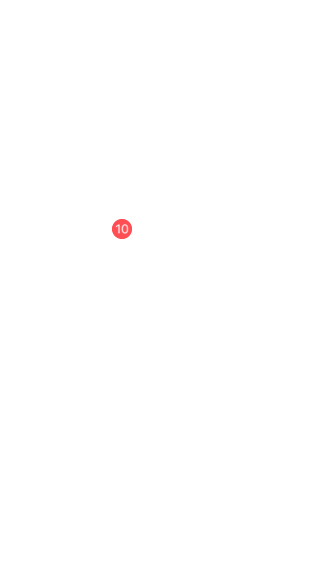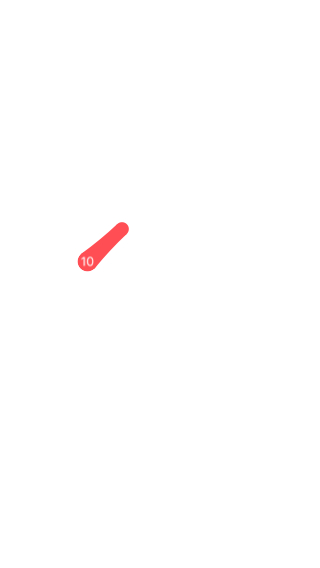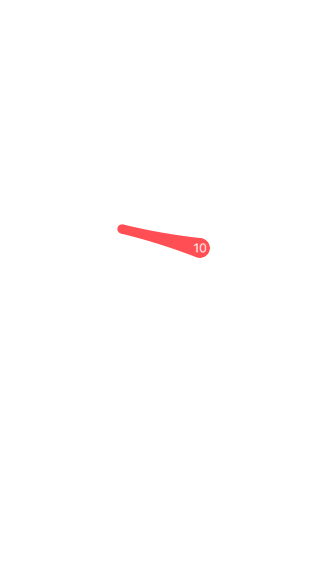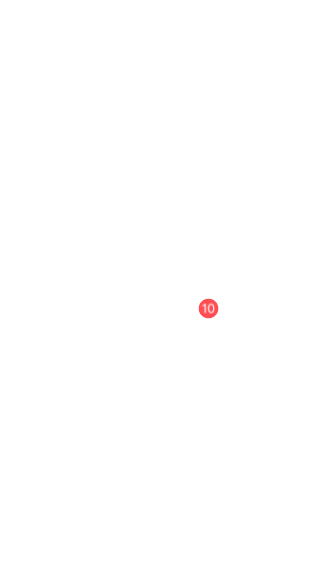QQ(iOS)客户端的粘性动画效果
qq的app中要是有新的联系人发消息过来,相应联系人的cell右边会有一个红色的圆圈表示消息条数。如果去触碰那个圆圈,可以发现它竟然会跟着手指的移动而移动。
在一定范围内,手指离开屏幕,会发现红色圆圈会自动弹性的回到原来的位置。而如果超出一定距离,这个圆圈会做一个销毁的动画,从而从view上移除掉。
产品要求公司的App也要有效果,并花了些时间去学习它的实现过程,发现其实原理还是比较简单的。
(由于mac制作gif图片实在过于麻烦,所以效果只能是看看图片。)
Demo的github地址:https://github.com/wzpziyi1/QQ-Goo
经过分析,可以发现,是两个圆和一个不规则矩形位置、大小的变化。一开始,小的圆圈和大的圆圈的center是相同的,当移动大圆的时候,小圆的半径随着大圆离小圆的距离变远而变小,当大圆距离小圆一定距离时,将小圆隐藏掉,中间的不规则矩形remove掉。
那么,不规则矩形怎么表示呢?可以利用Core Graphics在drawRect方法里面绘制不规则矩形的path,然后利用颜色fill就行。不规则矩形是随着大圆的移动而不断变化的,如果在drawRect方法里面绘制,那么在移动过程中不断调用setNeedsDisplay方法进行重绘。这是种可行的方案,我所用的也大致是这种思路。
不过,我没有在drawRect方法里面绘制,而是利用了CAShapeLayer,将不规则矩形的path绘制在shapeLayer里面,这样在移动大圆的过程中不断更新CAShapeLayer的path即可。
当然,难点并在在这里。而是不规则矩形的各个点的位置。要绘制这个不规则矩形,需要知道六个点的位置:
有了这些点的坐标,那么就可以用UIBezierPath来绘制相应的路径,代码如下:
- (UIBezierPath *)pathWithBigCircleView:(UIView *)bigCircleView smallCircleView:(UIView *)smallCircleView
{
CGPoint smallCircleCenter = smallCircleView.center;
CGFloat x1 = smallCircleCenter.x;
CGFloat y1 = smallCircleCenter.y;
CGFloat r1 = smallCircleView.bounds.size.width / 2;
CGPoint BigCircleViewCenter = bigCircleView.center;
CGFloat x2 = BigCircleViewCenter.x;
CGFloat y2 = BigCircleViewCenter.y;
CGFloat r2 = bigCircleView.bounds.size.width / 2;
CGFloat d = [self distanceWithPointA:BigCircleViewCenter pointB:smallCircleCenter];
//Θ:(xita)
CGFloat sinθ = (x2 - x1) / d;
CGFloat cosθ = (y2 - y1) / d;
CGPoint pointA = CGPointMake(x1 - r1 * cosθ , y1 + r1 * sinθ);
CGPoint pointB = CGPointMake(x1 + r1 * cosθ , y1 - r1 * sinθ);
CGPoint pointC = CGPointMake(x2 + r2 * cosθ , y2 - r2 * sinθ);
CGPoint pointD = CGPointMake(x2 - r2 * cosθ , y2 + r2 * sinθ);
CGPoint pointO = CGPointMake(pointA.x + d / 2 * sinθ , pointA.y + d / 2 * cosθ);
CGPoint pointP = CGPointMake(pointB.x + d / 2 * sinθ , pointB.y + d / 2 * cosθ);
UIBezierPath *path = [UIBezierPath bezierPath];
// D
[path moveToPoint:pointD];
// DA
[path addQuadCurveToPoint:pointA controlPoint:pointO];
// AB
[path addLineToPoint:pointB];
// BC
[path addQuadCurveToPoint:pointC controlPoint:pointP];
// CD
[path addLineToPoint:pointD];
return path;
}
在实现过程中,我是自定义UIButton的,需要注意的是,在监听button的拖动时,最好是给它添加UIPanGestureRecognizer手势,而不要在touchesBegin方法里面去判断它的移动位置,因为Touches系列方法会屏蔽button的点击。
自定义的这个button默认就是大圆,包含一个小圆(UIView)属性,但是这个小圆并不是添加在自定义的这个button(也就是大圆)里面,而是在button的superView上。因为小圆并不需要随着大圆位置的改变而改变位置,相应的,shapeLayer也是添加在button(大圆)的父控件上。
给大圆添加了pan手势,在pan:方法里面随之改变小圆的大小和绘制shapeLayer的path。
当pan手势状态为End的时候,需要判断大圆与小圆的距离有没有超出最大距离,如果超过,那么添加一个gif图片,播放销毁大圆的过程。如果没有被销毁,那么大圆需要复位,相应代码:
#import "ZYGooView.h"
#define kMaxDistance 100
@interface ZYGooView ()
@property (nonatomic, weak) UIView *smallCircleView;
@property (nonatomic, assign) CGFloat smallCircleR;
@property (nonatomic, weak) CAShapeLayer *shapeLayer;
@end
@implementation ZYGooView
- (instancetype)initWithFrame:(CGRect)frame
{
if (self = [super initWithFrame:frame]) {
[self commitInit];
}
return self;
}
- (void)awakeFromNib
{
[self commitInit];
}
- (void)commitInit
{
self.layer.cornerRadius = self.frame.size.width * 0.5;
self.layer.masksToBounds = YES;
self.smallCircleR = self.frame.size.width * 0.5;
self.smallCircleView.bounds = self.bounds;
self.smallCircleView.center = self.center;
self.smallCircleView.layer.cornerRadius = self.smallCircleView.frame.size.width * 0.5;
[self addGesture];
}
#pragma mark ----懒加载方法
- (UIView *)smallCircleView
{
if (_smallCircleView == nil) {
UIView *view = [[UIView alloc] init];
view.backgroundColor = self.backgroundColor;
[self.superview addSubview:view];
[self.superview insertSubview:view atIndex:0];
_smallCircleView = view;
}
return _smallCircleView;
}
- (CAShapeLayer *)shapeLayer
{
if (_shapeLayer == nil) {
CAShapeLayer *shapeLayer = [CAShapeLayer layer];
shapeLayer.path = [self pathWithBigCircleView:self smallCircleView:self.smallCircleView].CGPath;
shapeLayer.fillColor = self.backgroundColor.CGColor;
[self.superview.layer addSublayer:shapeLayer];
[self.superview.layer insertSublayer:shapeLayer atIndex:0];
_shapeLayer = shapeLayer;
}
return _shapeLayer;
}
#pragma mark ----其他方法
- (void)addGesture
{
UIPanGestureRecognizer *recognizer = [[UIPanGestureRecognizer alloc] initWithTarget:self action:@selector(pan:)];
[self addGestureRecognizer:recognizer];
}
- (void)pan:(UIPanGestureRecognizer *)recognizer
{
CGPoint point = [recognizer translationInView:self.superview];
CGPoint center = self.center;
center.x += point.x;
center.y += point.y;
self.center = center;
//复位
[recognizer setTranslation:CGPointZero inView:self];
CGFloat distance = [self distanceWithPointA:self.smallCircleView.center pointB:self.center];
if (distance == 0) return;
CGFloat newR = self.smallCircleR - distance / 15.0;
NSLog(@"%f", newR);
self.smallCircleView.bounds = CGRectMake(0, 0, newR * 2, newR * 2);
self.smallCircleView.layer.cornerRadius = newR;
if (distance > kMaxDistance || newR <= 0) {
self.smallCircleView.hidden = YES;
[self.shapeLayer removeFromSuperlayer];
self.shapeLayer = nil;
}
if (distance <= kMaxDistance && self.smallCircleView.hidden == NO) {
self.shapeLayer.path = [self pathWithBigCircleView:self smallCircleView:self.smallCircleView].CGPath;
}
if (recognizer.state == UIGestureRecognizerStateEnded) {
if (distance <= kMaxDistance) {
dispatch_after(dispatch_time(DISPATCH_TIME_NOW, (int64_t)(0.03 * NSEC_PER_SEC)), dispatch_get_main_queue(), ^{
[self.shapeLayer removeFromSuperlayer];
self.shapeLayer = nil;
});
[UIView animateWithDuration:0.4 delay:0 usingSpringWithDamping:0.6 initialSpringVelocity:0 options:UIViewAnimationOptionCurveLinear animations:^{
self.center = self.smallCircleView.center;
} completion:^(BOOL finished) {
self.smallCircleView.hidden = NO;
}];
}
else {
UIImageView *imageView = [[UIImageView alloc] initWithFrame:self.bounds];
[self addSubview:imageView];
NSMutableArray *images = [NSMutableArray array];
for (int i = 1; i <= 8; i++) {
NSString *imageName = [NSString stringWithFormat:@"%d", i];
UIImage *image = [UIImage imageNamed:imageName];
[images addObject:image];
}
imageView.animationImages = images;
imageView.animationDuration = 0.6;
imageView.animationRepeatCount = 1;
[imageView startAnimating];
dispatch_after(dispatch_time(DISPATCH_TIME_NOW, (int64_t)(0.5 * NSEC_PER_SEC)), dispatch_get_main_queue(), ^{
[self removeFromSuperview];
});
}
}
}
- (CGFloat)distanceWithPointA:(CGPoint)pointA pointB:(CGPoint)pointB
{
CGFloat dx = pointB.x - pointA.x;
CGFloat dy = pointB.y - pointA.y;
return sqrt(dx * dx + dy * dy);
}
- (UIBezierPath *)pathWithBigCircleView:(UIView *)bigCircleView smallCircleView:(UIView *)smallCircleView
{
CGPoint smallCircleCenter = smallCircleView.center;
CGFloat x1 = smallCircleCenter.x;
CGFloat y1 = smallCircleCenter.y;
CGFloat r1 = smallCircleView.bounds.size.width / 2;
CGPoint BigCircleViewCenter = bigCircleView.center;
CGFloat x2 = BigCircleViewCenter.x;
CGFloat y2 = BigCircleViewCenter.y;
CGFloat r2 = bigCircleView.bounds.size.width / 2;
CGFloat d = [self distanceWithPointA:BigCircleViewCenter pointB:smallCircleCenter];
//Θ:(xita)
CGFloat sinθ = (x2 - x1) / d;
CGFloat cosθ = (y2 - y1) / d;
CGPoint pointA = CGPointMake(x1 - r1 * cosθ , y1 + r1 * sinθ);
CGPoint pointB = CGPointMake(x1 + r1 * cosθ , y1 - r1 * sinθ);
CGPoint pointC = CGPointMake(x2 + r2 * cosθ , y2 - r2 * sinθ);
CGPoint pointD = CGPointMake(x2 - r2 * cosθ , y2 + r2 * sinθ);
CGPoint pointO = CGPointMake(pointA.x + d / 2 * sinθ , pointA.y + d / 2 * cosθ);
CGPoint pointP = CGPointMake(pointB.x + d / 2 * sinθ , pointB.y + d / 2 * cosθ);
UIBezierPath *path = [UIBezierPath bezierPath];
// D
[path moveToPoint:pointD];
// DA
[path addQuadCurveToPoint:pointA controlPoint:pointO];
// AB
[path addLineToPoint:pointB];
// BC
[path addQuadCurveToPoint:pointC controlPoint:pointP];
// CD
[path addLineToPoint:pointD];
return path;
}
@end
Demo的github地址:https://github.com/wzpziyi1/QQ-Goo









 浙公网安备 33010602011771号
浙公网安备 33010602011771号